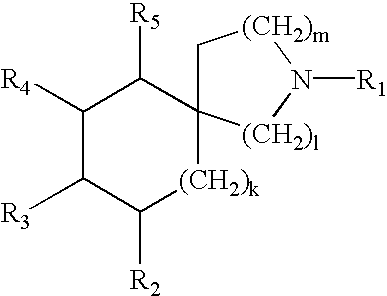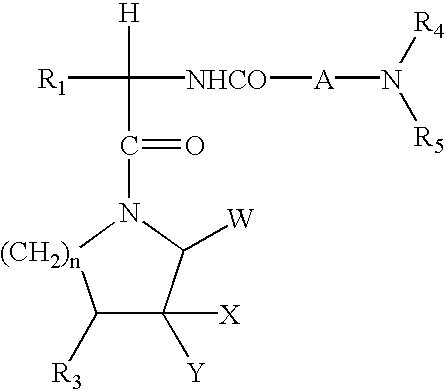N-ureidoalkyl-piperidines as modulators of chemokine receptor activity
a technology of n-ureidoalkyl-piperidines and which is applied in the field of modulators of chemokine receptor activity, can solve the problems of not being disclosed nor suggested in the prior ar
- Summary
- Abstract
- Description
- Claims
- Application Information
AI Technical Summary
Problems solved by technology
Method used
Image
Examples
example 1
[0378]Part A: Preparation of 4-benzyl-1-(3-N-phthalimido-n-prop-1-yl)piperidine
[0379]4-benzylpiperidine (8.0 g, 45.6 mmol, 1 eq), N-(3-bromopropyl)-phthalimide (13.5 g, 50.2 mmol, 1.1 eq), potassium iodide (7.6 g, 45.6 mmol, 1 eq) and potassium carbonate (2.6 g, 91.3 mmol, 2 eq) were refluxed in 125 mL of 2-butanone. The reaction was worked up after 5 hours by filtering off the inorganic solids then adding EtOAc and rinsing the organic layer 2× with water. The organic layer was dried over magnesium sulfate then the solvent removed in vacuo to obtain an amber oil. The oil was purified by flash chromatography in 100% EtOAc to remove impurities then 8:2 chloroform / methanol to isolate 3.67 g of the product as a light amber oil. NMR(300 MHz, CDCl3) δ 8.00-7.80 (m, 2H); 7.80-7.60 (m, 2H);7.35-7.10 (m, 3H); 7.08 (d, 2H, J=7 Hz); 3.76 (t, 2H, J=7 Hz); 2.83 (d, 2H, J=10 Hz); 2.45-2.30 (m, 4H); 1.95-1.30 (m, 7H); 1.20-0.90 (m, 2H).
Part B: Preparaton of 4-benzyl-1-(3-amino-n-prop-1-yl)piperid...
example 2
[0382]Part A: Preparation of 4-benzyl-1-carbomethoxymethyl-1-[3-(3-cyanophenylaminocarbonylamino)prop-1-yl]piperidinium bromide
[0383]4-benzyl-1-[3-(3-cyanophenylaminocarbonylamino)prop-1-yl]piperidine (50 mg, 0.133 mmol, 1 eq), was dissoved in acetone at 25° C. under N2 then methyl bromoacetate (13 μL, 0.133 mmol, 1 eq),was added. After 16 hours, the solvent was removed in vacuo and the residue was purified over silica gel in 100% EtOAc to 8:2 chloroform / MeOH to yield 50 mg of white solids as product. NMR (300 MHz, CD3OD) δ 8.00-7.80 (m, 1H); 7.65-7.45 (m, 1H); 7.45-7.33 (m, 1H); 7.33-7.05 (m, 6H); 4.50-4.25 (m, 2H); 4.00-3.60 (m, 5H); 3.50-3.20 (m, 6H); 2.70-2.50 (m, 2H); 2.10-1.60 (m, 7H).
example 3
[0384]Part A: Preparation of 1-(t-Butoxycarbonyl)-3-piperidone
[0385]To a deep yellow solution of 1-benzyl-3-piperidone hydrochloride (3.00 g, 1.33 mmol, 1 equiv) in methanol (100 mL) was added 10 wt. % (dry basis) palladium on activated carbon (600 mg) under a stream of nitrogen. The resulting black suspension was deoxygenated by alternate evacuation and flushing with nitrogen (3×) followed by alternate evacuation and flushing with hydrogen (3×). The reaction suspension was then shaken vigorously under a hydrogen atmosphere of 55 psi. After 12 hours, gravity filtration of the supsension and concentration of the resulting filtrate in vacuo yielded crude 3-piperidone as a viscous light green oil. The oil was immediately treated with tetrahydrofuran (150 mL) and di-t-butyldicarbonate (4.73 g, 21.7 mmol, 0.98 equiv). Upon addition of saturated aqueous sodium bicarbonate (25 mL), the oil completely dissolved to give a light yellow suspension. After stirring the suspension vigorously for...
PUM
| Property | Measurement | Unit |
|---|---|---|
| molecular weight | aaaaa | aaaaa |
| temperature | aaaaa | aaaaa |
| pH | aaaaa | aaaaa |
Abstract
Description
Claims
Application Information
 Login to View More
Login to View More - R&D
- Intellectual Property
- Life Sciences
- Materials
- Tech Scout
- Unparalleled Data Quality
- Higher Quality Content
- 60% Fewer Hallucinations
Browse by: Latest US Patents, China's latest patents, Technical Efficacy Thesaurus, Application Domain, Technology Topic, Popular Technical Reports.
© 2025 PatSnap. All rights reserved.Legal|Privacy policy|Modern Slavery Act Transparency Statement|Sitemap|About US| Contact US: help@patsnap.com



